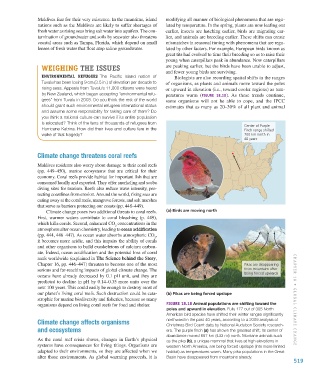Page 520 - Environment: The Science Behind the Stories
P. 520
Maldives fear for their very existence. In the meantime, island modifying all manner of biological phenomena that are regu-
nations such as the Maldives are likely to suffer shortages of lated by temperature. In the spring, plants are now leafing out
fresh water as rising seas bring salt water into aquifers. The con- earlier, insects are hatching earlier, birds are migrating ear-
tamination of groundwater and soils by seawater also threatens lier, and animals are breeding earlier. These shifts can create
coastal areas such as Tampa, Florida, which depend on small mismatches in seasonal timing with phenomena that are regu-
lenses of fresh water that float atop saline groundwater. lated by other factors. For example, European birds known as
great tits had evolved to time their breeding so as to raise their
young when caterpillars peak in abundance. Now caterpillars
WEIGHING THE ISSUES are peaking earlier, but the birds have been unable to adjust,
and fewer young birds are surviving.
ENvIRONMENTAL REFUGEES The Pacific island nation of Biologists are also recording spatial shifts in the ranges
Tuvalu has been losing 9 cm (3.5 in.) of elevation per decade to of organisms, as plants and animals move toward the poles
rising seas. Appeals from Tuvalu’s 11,000 citizens were heard or upward in elevation (i.e., toward cooler regions) as tem-
by New Zealand, which began accepting “environmental refu- peratures warm (Figure 18.18). As these trends continue,
gees” from Tuvalu in 2003. Do you think the rest of the world some organisms will not be able to cope, and the IPCC
should grant such environmental refugees international status estimates that as many as 20–30% of all plant and animal
and assume some responsibility for taking care of them? Do
you think a national culture can survive if its entire population
is relocated? Think of the tens of thousands of refugees from Center of Purple
Hurricane Katrina. How did their lives and culture fare in the Finch range shifted
wake of that tragedy? 700 km north in
40 years
Climate change threatens coral reefs
Maldives residents also worry about damage to their coral reefs
(pp. 449–450), marine ecosystems that are critical for their
economy. Coral reefs provide habitat for important fish that are
consumed locally and exported. They offer snorkeling and scuba
diving sites for tourism. Reefs also reduce wave intensity, pro-
tecting coastlines from erosion. Around the world, rising seas are
eating away at the coral reefs, mangrove forests, and salt marshes
that serve as barriers protecting our coasts (pp. 448–449).
Climate change poses two additional threats to coral reefs. (a) Birds are moving north
First, warmer waters contribute to coral bleaching (p. 449),
which kills corals. Second, enhanced CO concentrations in the
2
atmosphere alter ocean chemistry, leading to ocean acidification
(pp. 444, 446–447). As ocean water absorbs atmospheric CO ,
2
it becomes more acidic, and this impairs the ability of corals
and other organisms to build exoskeletons of calcium carbon-
ate. Indeed, ocean acidification and the potential loss of coral
reefs worldwide (explained in The Science behind the Story,
Chapter 16, pp. 446–447) threaten to become one of the most Pikas are disappearing
serious and far-reaching impacts of global climate change. The from mountains after
oceans have already decreased by 0.1 pH unit, and they are being forced upwards
predicted to decline in pH by 0.14–0.35 more units over the
next 100 years. This could easily be enough to destroy most of
our planet’s living coral reefs. Such destruction could be cata- (b) Pikas are being forced upslope
strophic for marine biodiversity and fisheries, because so many CHAPTER 18 • Glob al Cli M aT e Chan G e
organisms depend on living coral reefs for food and shelter. Figure 18.18 Animal populations are shifting toward the
poles and upward in elevation. Fully 177 out of 305 North
American bird species have shifted their winter ranges significantly
Climate change affects organisms northward in the past 40 years, according to a 2009 analysis of
Christmas Bird Count data by National Audubon Society research-
and ecosystems ers. The purple finch (a) has shown the greatest shift; its center of
abundance moved 697 km (433 mi) north. Montane animals such
As the coral reef crisis shows, changes in Earth’s physical as the pika (b), a unique mammal that lives at high elevations in
systems have consequences for living things. Organisms are western North America, are being forced upslope (into more limited
adapted to their environments, so they are affected when we habitat) as temperatures warm. Many pika populations in the Great
alter those environments. As global warming proceeds, it is Basin have disappeared from mountains already.
519
M18_WITH7428_05_SE_C18.indd 519 12/12/14 4:05 PM

